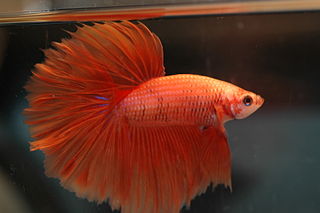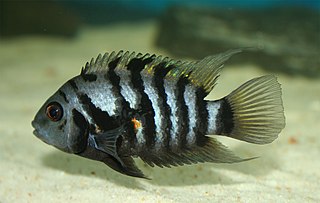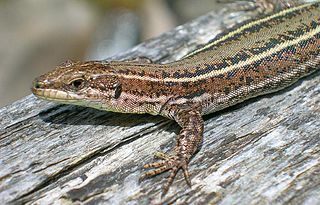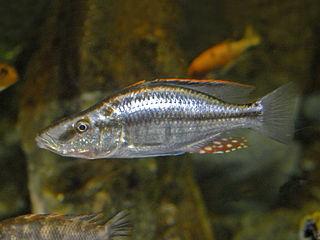
Cichlids are fish from the family Cichlidae in the order Cichliformes. Traditionally Cichlids were classed in a suborder, the Labroidei, along with the wrasses (Labridae), in the order Perciformes, but molecular studies have contradicted this grouping. On the basis of fossil evidence, it first appeared in Tanzania during the Eocene epoch, about 46–45 million years ago. The closest living relative of cichlids is probably the convict blenny, and both families are classified in the 5th edition of Fishes of the World as the two families in the Cichliformes, part of the subseries Ovalentaria. This family is large, diverse, and widely dispersed. At least 1,650 species have been scientifically described, making it one of the largest vertebrate families. New species are discovered annually, and many species remain undescribed. The actual number of species is therefore unknown, with estimates varying between 2,000 and 3,000.

The oscar is a species of fish from the cichlid family known under a variety of common names, including tiger oscar, velvet cichlid, and marble cichlid. In tropical South America, where the species naturally resides, A. ocellatus specimens are often found for sale as a food fish in the local markets. The fish has been introduced to other areas, including India, China, Australia, and the United States. It is considered a popular aquarium fish in Europe and the U.S.

In ethology, territory is the sociographical area that an animal consistently defends against conspecific competition using agonistic behaviors or real physical aggression. Animals that actively defend territories in this way are referred to as being territorial or displaying territorialism.

The ring-tailed lemur is a medium- to larger-sized strepsirrhine (wet-nosed) primate, and the most internationally-recognized lemur species, owing to its long, black-and-white, ringed tail. It belongs to Lemuridae, one of five lemur families, and is the only member of the Lemur genus. Like all lemurs, it is endemic to the island of Madagascar, where it is endangered. Known locally in Malagasy as maky or hira, it ranges from gallery forests to spiny scrub in the southern regions of the island. It is omnivorous, as well as the most adapted to living terrestrially of the extant lemurs.

In biology, a dominance hierarchy is a type of social hierarchy that arises when members of animal social groups interact, creating a ranking system. A dominant higher-ranking individual is sometimes called an alpha, and a submissive lower-ranking individual is called a beta. Different types of interactions can result in dominance depending on the species, including ritualized displays of aggression or direct physical violence. In social living groups, members are likely to compete for access to limited resources and mating opportunities. Rather than fighting each time they meet, individuals of the same sex establish a relative rank, with higher-ranking individuals often gaining more access to resources and mates. Based on repetitive interactions, a social order is created that is subject to change each time a dominant animal is challenged by a subordinate one.

The Siamese fighting fish, commonly known as the betta, is a freshwater fish native to Southeast Asia, namely Cambodia, Laos, Myanmar, Malaysia, Indonesia, Thailand, and Vietnam. It is one of 73 species of the genus Betta, but the only one eponymously called "betta", owing to its global popularity as a pet; Betta splendens are among the most popular aquarium fish in the world, due to their diverse and colorful morphology and relatively low maintenance.

The convict cichlid is a fish species from the family Cichlidae, native to Central America, also known as the zebra cichlid. Convict cichlids are popular aquarium fish and have also been the subject of numerous studies on fish behaviour.

Podarcis hispanicus, also known as Iberian wall lizard, is a small wall lizard species of the genus Podarcis. It is found in the Iberian peninsula, in northwestern Africa and in coastal districts in Languedoc-Roussillon in France. In Spanish, this lizard is commonly called lagartija Ibérica.
The Tennessee dace is a species of ray-finned fish in the family Cyprinidae. It is found only in the United States; particularly in northeast Tennessee and southwest Virginia, and parts of extreme northwest Georgia. Until recently, they were considered a subspecies of mountain redbelly dace. They are commonly found in East Tennessee in spring fed first-order streams, often in silt and fine gravel pools, or undercut banks. These streams usually do not exceed two meters in width.

Agonistic behaviour is any social behaviour related to fighting. The term has broader meaning than aggressive behaviour because it includes threats, displays, retreats, placation, and conciliation. The term "agonistic behaviour" was first implemented by J.P Scott and Emil Fredericson in 1951 in their paper "The Causes of Fighting in Mice and Rats" in Physiological Zoology.Agonistic behaviour is seen in many animal species because resources including food, shelter, and mates are often limited.

The Malawi eyebiter is a species of fish in the family Cichlidae. This predatory cichlid is endemic to Lake Malawi in East Africa.

Neolamprologus pulcher is a species of cichlid endemic to Lake Tanganyika where it prefers locations with plenty of sedimentation. The common names for N. pulcher include daffodil cichlid, fairy cichlid, princess of Zambia and lyretail cichlid. This species can reach a length of 10 centimetres (3.9 in) TL. It can also be found in the aquarium trade.

Semotilus atromaculatus, known as the creek chub or the common creek chub, is a small minnow, a freshwater fish found in the eastern US and Canada. Differing in size and color depending on origin of development, the creek chub can usually be defined by a dark brown body with a black lateral line spanning horizontally across the body. It lives primarily within streams and rivers. Creek chubs attain lengths of 2-6 inches with larger specimens of up to 12 inches possible. The genus name Semotilus derives from the Greek word sema, and atromaculatus comes from the Latin word "black spots".

The goldeneye cichlid is a species of cichlid found in fresh water from the Aruka River in Guyana, to the Maroni River in Suriname. It is often found on flooded savannas near the coast. The male grows to a length of about 5.6 centimetres (2.2 in) while the female is somewhat smaller, and is thus regarded as a dwarf cichlid.

Fish intelligence is the resultant of the process of acquiring, storing in memory, retrieving, combining, comparing, and using in new contexts information and conceptual skills" as it applies to fish.
The dear enemy effect or dear enemy recognition is an ethological phenomenon in which two neighbouring territorial animals become less aggressive toward one another once territorial borders are well established. As territory owners become accustomed to their neighbours, they expend less time and energy on defensive behaviors directed toward one another. However, aggression toward unfamiliar neighbours remains the same. Some authors have suggested the dear enemy effect is territory residents displaying lower levels of aggression toward familiar neighbours compared to unfamiliar individuals who are non-territorial "floaters".

The black-faced blenny is a small benthic fish from the family Tripterygiidae (triplefin-blennies). It occurs at depths of 3 to 40 metres and lives on the substrate under large rocks, cliffs or other overhangs.
Aggression refers to negative behavior or attitudes toward another, mainly by applying physical force. Evolution on the other hand, is any process of formation or development of something like habit, trait or character in a population from generation to generation. Evolution can explain why fish exhibit aggression because it is a simple emotion. This emotion increases an individual's survival or reproduction. Aggressive behavior can derive in fish species due to territory, sex specific selection and genetic variation. There is no specific fish species who display invasive behavior. Almost all the fish are aggressive sometimes in their lives depending on their surroundings.
The Dixie chub is a species of freshwater ray-finned fish from the carp and minnow family Cyprinidae. It is endemic to southeastern United States.















